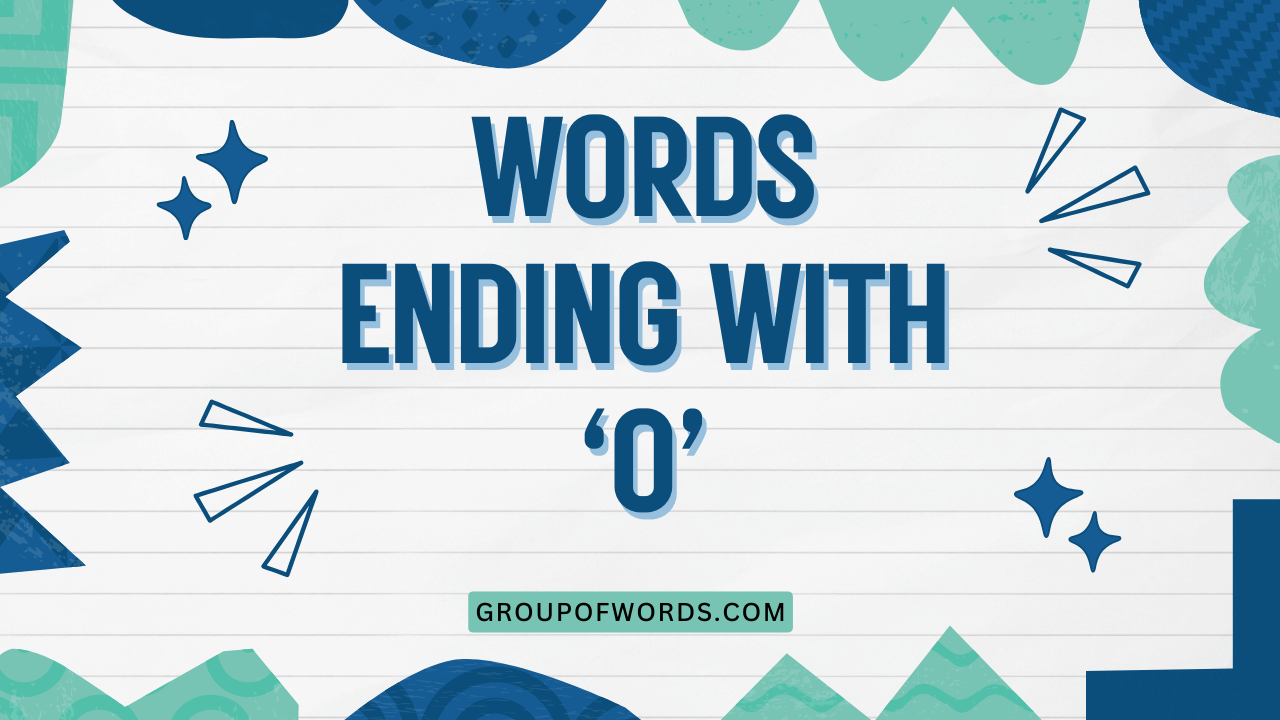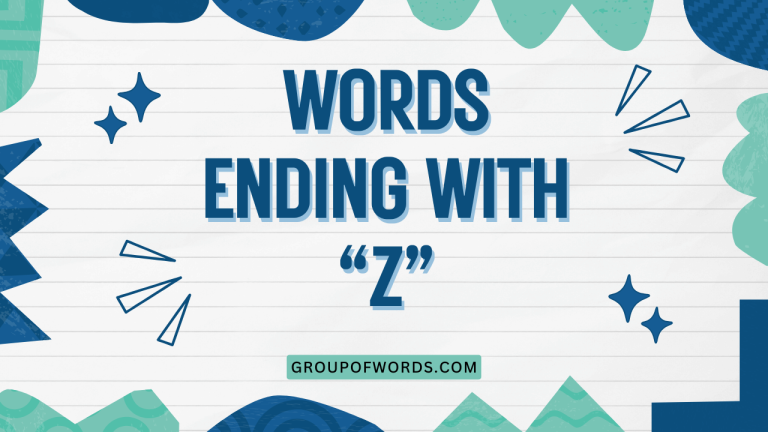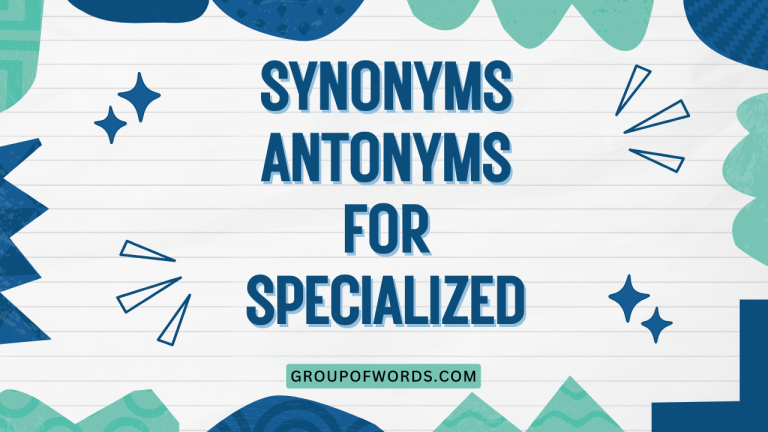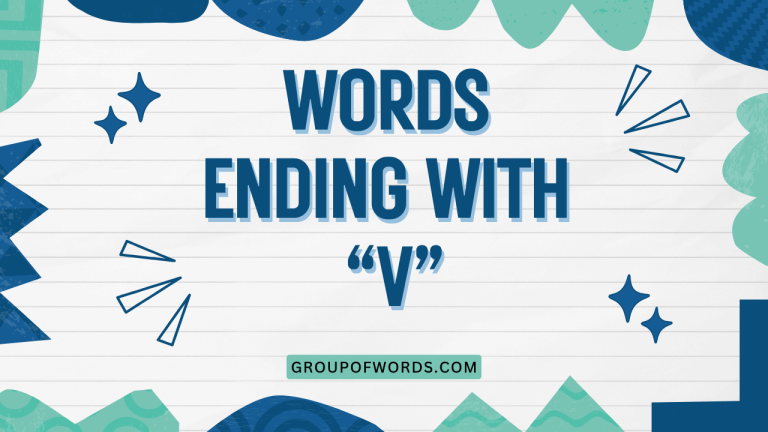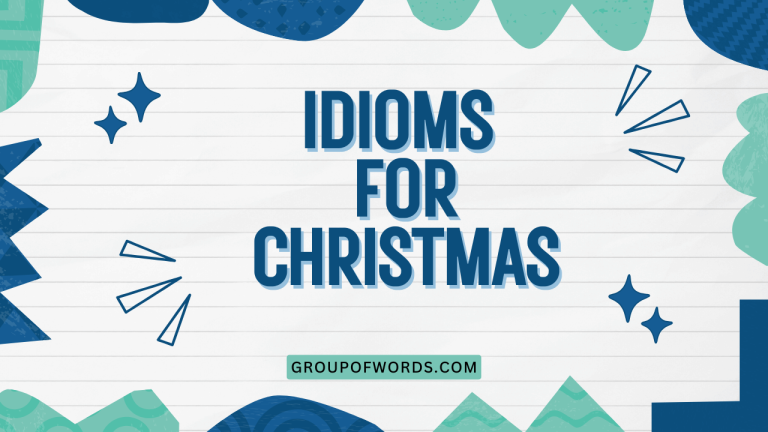Words Ending in ‘O’: A Comprehensive Grammar Guide
English grammar can sometimes feel like navigating a maze, especially when dealing with words that don’t always follow predictable rules. One such area is words ending in ‘o’.
While many languages, like Spanish and Italian, readily pluralize nouns ending in ‘o’ by simply adding an ‘s’, English often presents a more complex picture. Understanding the rules, exceptions, and nuances surrounding these words is crucial for accurate and effective communication.
This guide will provide a detailed exploration of words ending in ‘o’, covering their formation, usage, and common pitfalls. Whether you’re an ESL student, a writer looking to refine your skills, or simply curious about the intricacies of the English language, this article will equip you with the knowledge you need to master this fascinating aspect of grammar.
This article will benefit anyone who wants to improve their English grammar, vocabulary, and writing skills. It’s particularly useful for ESL learners, students preparing for English proficiency tests, and writers who want to ensure their work is grammatically correct and stylistically polished.
By the end of this guide, you’ll be able to confidently use words ending in ‘o’ in your spoken and written English.
Table of Contents
- Definition: Words Ending in ‘O’
- Structural Breakdown
- Types and Categories
- Examples
- Usage Rules
- Common Mistakes
- Practice Exercises
- Advanced Topics
- FAQ
- Conclusion
Definition: Words Ending in ‘O’
Words ending in ‘o’ encompass a diverse range of parts of speech, including nouns, adjectives, verbs, and interjections. Their behavior in English, particularly regarding pluralization and grammatical function, can vary significantly. Understanding the role of these words within a sentence and their origins often provides clues to their correct usage and inflection. These words are not limited to any specific origin or subject matter, appearing across various fields from science (e.g., photo, micro) to music (e.g., solo, tempo) and everyday language (e.g., hello, go).
The classification of a word ending in ‘o’ depends on its function within a sentence. For instance, in the sentence “He played the piano,” piano is a noun. In “The solo performance was captivating,” solo functions as an adjective describing the performance. The context of the sentence determines the word’s grammatical category. Moreover, some words can function as multiple parts of speech depending on the context. For example, “go” can be a verb (“I will go“) or a noun (“Let’s have a go at it”). This flexibility adds to the complexity but also the richness of the English language.
Structural Breakdown
The structure of words ending in ‘o’ is relatively straightforward: a root word followed by the letter ‘o’. However, the pronunciation of the ‘o’ can vary widely depending on the word and its origin. It can be a long ‘o’ as in photo, a short ‘o’ as in tomato, or even a schwa sound as in some unstressed syllables. The preceding letters significantly influence the pronunciation. For example, ‘ch’ before ‘o’ often produces a ‘k’ sound, as in echo and stomach. The etymology of the word plays a crucial role in determining its pronunciation and pluralization.
In terms of grammatical structure, the ‘o’ ending doesn’t inherently dictate a word’s function but rather serves as a characteristic feature. The surrounding words and the sentence structure provide the necessary clues to determine the word’s role.
Furthermore, many words ending in ‘o’ are borrowed from other languages, particularly Italian, Spanish, and Greek, which contributes to the variety in pronunciation and pluralization rules. Recognizing these linguistic influences can help learners predict and understand the correct usage of these words.
Types and Categories
Words ending in ‘o’ can be categorized based on their part of speech. The most common categories are nouns, adjectives, verbs, and interjections.
Each category has its own typical usage and grammatical rules.
Nouns
Nouns ending in ‘o’ represent people, places, things, or ideas. They can be concrete (e.g., potato, volcano) or abstract (e.g., tempo, ego). The pluralization of these nouns is a common area of confusion for English learners, as some form their plural by adding ‘s’ while others add ‘es’.
Adjectives
Adjectives ending in ‘o’ describe nouns. They often indicate a quality or characteristic. Examples include solo, immuno (as in immunocompromised), and stereo (as in stereo sound). These adjectives usually do not change form to agree with the noun they modify.
Verbs
Verbs ending in ‘o’ are less common but do exist, particularly in informal or specialized contexts. Examples include go, outdo, and some conjugated forms of verbs borrowed from other languages. These verbs follow the standard rules of verb conjugation in English.
Interjections
Interjections ending in ‘o’ express sudden emotion or surprise. Common examples include hello, whoa, and yo. These words are often used in informal speech and writing and typically stand alone or at the beginning of a sentence.
Examples
To illustrate the usage of words ending in ‘o’, let’s examine examples for each category: nouns, adjectives, verbs, and interjections. These examples will provide a clearer understanding of their grammatical functions and contexts.
Noun Examples
Nouns ending in ‘o’ are quite common in English. Some follow the regular pluralization rule of adding ‘s’, while others require ‘es’.
The table below provides a diverse range of examples.
| Noun (Singular) | Noun (Plural) | Example Sentence |
|---|---|---|
| Photo | Photos | I took many photos on my vacation. |
| Piano | Pianos | The music store sells a variety of pianos. |
| Radio | Radios | Old radios are often collected as antiques. |
| Video | Videos | She uploads videos to her YouTube channel. |
| Kilo | Kilos | I need to buy a few kilos of apples. |
| Logo | Logos | The company designed new logos for their products. |
| Memo | Memos | The boss sent out several memos this week. |
| Zero | Zeros | The temperature dropped below zero last night. |
| Hero | Heroes | The firefighters are considered heroes in our town. |
| Potato | Potatoes | We need to buy potatoes for dinner. |
| Tomato | Tomatoes | The garden is full of ripe tomatoes. |
| Volcano | Volcanoes | Several volcanoes are active around the world. |
| Echo | Echoes | The echoes in the cave were very loud. |
| Torpedo | Torpedoes | The submarine launched two torpedoes. |
| Cargo | Cargoes/Cargos | The ship carried various cargoes across the sea. |
| Ghetto | Ghettos | Historically, ghettos were areas where marginalized groups lived. |
| Mango | Mangos/Mangoes | I bought some delicious mangos at the market. |
| Motto | Mottos/Mottoes | The family’s motto was “Always persevere.” |
| Oboe | Oboes | The orchestra has several skilled oboes players. |
| Domino | Dominos/Dominoes | We played a game of dominos last night. |
| Studio | Studios | The artist has two studios, one for painting and one for sculpture. |
| Tornado | Tornadoes/Tornados | Several tornadoes touched down in the Midwest this year. |
| Avocado | Avocados | We added sliced avocados to our salad. |
| Embargo | Embargoes | The country imposed embargoes on certain goods. |
| Flamingo | Flamingos | The zoo has a large flock of pink flamingos. |
| Bingo | Bingos | They played several rounds of bingos at the community center. |
Adjective Examples
Adjectives ending in ‘o’ are used to describe nouns, adding detail and specificity. These adjectives typically do not change their form.
| Adjective | Example Sentence |
|---|---|
| Solo | She gave a solo performance on the violin. |
| Immuno | The patient is immunocompromised due to the medication. |
| Stereo | The car has a stereo sound system. |
| Dynamo | He is a dynamo player on the team. |
| In vitro | The in vitro fertilization process was successful. |
| Primo | He secured the primo spot in the competition. |
| Retro | The party had a retro theme. |
| Subzero | The temperature outside was subzero. |
| Turbo | The car has a turbo engine. |
| Video | The band released a new video song. |
| Audio | The podcast is available in audio format. |
| Bio | The company is developing bio fuels. |
| Eco | The hotel promotes eco tourism. |
| Geo | They conducted a geo survey of the region. |
| Neuro | The doctor specializes in neuro surgery. |
| Photo | The website uses photo editing software. |
| Psycho | The movie has a psycho thriller plot. |
| Techno | The club played techno music all night. |
| Thermo | The building uses thermo insulation. |
| Uno | The children played uno cards during the trip. |
| Macho | He tried to act macho in front of his friends. |
Verb Examples
Verbs ending in ‘o’ are less frequent but still present in the English language. “Go” is the most common example, but other verbs can be formed or borrowed from other languages.
| Verb | Example Sentence |
|---|---|
| Go | I will go to the store later. |
| Outdo | He always tries to outdo his competitors. |
| Echo | His voice echoed through the empty hall. |
| Inferno | The firefighters worked hard to prevent the fire from inferno-ing the whole town. |
| Stucco | They decided to stucco the exterior walls of their new house. |
Interjection Examples
Interjections ending in ‘o’ are used to express emotions or reactions. They are typically used in informal contexts.
| Interjection | Example Sentence |
|---|---|
| Hello | Hello, how are you today? |
| Whoa | Whoa, that was a close call! |
| Yo | Yo, what’s up? |
| Oho | Oho, so that’s what you were planning! |
Usage Rules
The usage of words ending in ‘o’ is governed by several rules, particularly concerning pluralization and context. These rules are not always consistent, and exceptions abound, making it essential to understand the underlying principles.
Pluralization of Nouns Ending in ‘O’
The pluralization of nouns ending in ‘o’ is one of the most challenging aspects for English learners. The general rule is that some nouns add ‘s’ to form the plural, while others add ‘es’.
There is no foolproof way to predict which rule a noun will follow, but some patterns can be observed.
Nouns of foreign origin, particularly from Italian or Spanish, often add only ‘s’. Examples include piano (pianos), photo (photos), and video (videos). However, this is not a strict rule, and many exceptions exist.
Nouns that are shortened forms or abbreviations also typically add only ‘s’. Examples include kilo (kilos), logo (logos), and memo (memos).
Other nouns, especially those of older origin or those that have been fully assimilated into English, often add ‘es’. Examples include potato (potatoes), tomato (tomatoes), and hero (heroes).
Exceptions to Pluralization Rules
As with many grammar rules in English, there are numerous exceptions to the pluralization rules for nouns ending in ‘o’. Some nouns can take either ‘s’ or ‘es’ in the plural form, while others have irregular plural forms altogether.
Examples of nouns that can take either ‘s’ or ‘es’ include cargo (cargoes/cargos), mango (mangoes/mangos), motto (mottoes/mottos), domino (dominoes/dominos), and tornado (tornadoes/tornados). In these cases, both forms are generally accepted, although one form may be more common than the other depending on the region or context.
It’s also important to note that some words ending in ‘o’ are uncountable nouns and do not have a plural form. An example is stucco.
Words Borrowed from Other Languages
Many English words ending in ‘o’ are borrowed from other languages, particularly Italian, Spanish, and Greek. The etymology of a word can often provide clues to its pronunciation and pluralization.
For example, words of Italian origin, such as piano and solo, tend to retain their original pronunciation and pluralization rules. Similarly, words of Spanish origin, such as macho and mosquito, often follow Spanish pronunciation patterns.
Recognizing the linguistic origin of a word can help learners understand its correct usage and avoid common mistakes. Consulting a dictionary or etymological resource can be helpful in determining a word’s origin and its associated rules.
Common Mistakes
One of the most common mistakes is incorrectly pluralizing nouns ending in ‘o’. Learners often assume that all nouns ending in ‘o’ follow the same pluralization rule, leading to errors such as “potatos” instead of “potatoes” or “heros” instead of “heroes.” Another common mistake is mispronouncing words.
For instance, pronouncing “echo” with a hard “ch” sound instead of a “k” sound.
Another frequent error is using the wrong part of speech. For example, using “solo” as a verb when it should be an adjective or noun.
Understanding the context and grammatical function of the word is crucial to avoid these mistakes.
Here are some examples of common mistakes and their corrections:
| Incorrect | Correct | Explanation |
|---|---|---|
| I bought some potatos. | I bought some potatoes. | “Potato” takes the plural form “potatoes.” |
| There were many heros in the war. | There were many heroes in the war. | “Hero” takes the plural form “heroes.” |
| The child played the pianoes. | The child played the pianos. | “Piano” takes the plural form “pianos.” |
| He is a very macho man. | He is a very macho man. | “Macho” does not need to be pluralized as it is an adjective. |
| The ship had many different cargos. | The ship had many different cargoes. | While “cargos” is accepted, “cargoes” is more common. |
Practice Exercises
To solidify your understanding of words ending in ‘o’, complete the following exercises. These exercises cover pluralization, identifying correct usage, and sentence completion.
Exercise 1: Pluralization
Provide the plural form of the following nouns:
| Singular Noun | Plural Noun |
|---|---|
| 1. Photo | |
| 2. Tomato | |
| 3. Piano | |
| 4. Hero | |
| 5. Radio | |
| 6. Volcano | |
| 7. Kilo | |
| 8. Mango | |
| 9. Echo | |
| 10. Logo |
Answer Key:
| Singular Noun | Plural Noun |
|---|---|
| 1. Photo | Photos |
| 2. Tomato | Tomatoes |
| 3. Piano | Pianos |
| 4. Hero | Heroes |
| 5. Radio | Radios |
| 6. Volcano | Volcanoes |
| 7. Kilo | Kilos |
| 8. Mango | Mangos/Mangoes |
| 9. Echo | Echoes |
| 10. Logo | Logos |
Exercise 2: Identifying Correct Usage
Choose the correct sentence in each pair:
-
a) I saw many potatos at the market.
b) I saw many potatoes at the market. -
a) The heros of the story were very brave.
b) The heroes of the story were very brave. -
a) She collected old radios.
b) She collected old radioes. -
a) The company designed new logos.
b) The company designed new logoes. -
a) We need to buy more tomatos.
b) We need to buy more tomatoes. -
a) The volcanoes erupted last year.
b) The volcanos erupted last year. -
a) He has a collection of vintage pianos.
b) He has a collection of vintage pianoes. -
a) The photographer took beautiful photos.
b) The photographer took beautiful photoes. -
a) The ship carried several cargos.
b) The ship carried several cargoes. -
a) They sell kilos of rice.
b) They sell kiloses of rice.
Answer Key:
- b
- b
- a
- a
- b
- a
- a
- a
- b
- a
Exercise 3: Sentence Completion
Complete the following sentences with the correct form of the word in parentheses:
- The walls of the house were covered in ____________ (stucco).
- She gave a ____________ (solo) performance at the concert.
- The doctor specializes in ____________ (neuro) surgery.
- We watched several ____________ (video) on YouTube.
- The temperature dropped to ____________ (subzero) last night.
- The company promotes ____________ (eco) tourism.
- The car has a powerful ____________ (turbo) engine.
- ____________ (hello), is anyone there?
- The athlete tried to ____________ (outdo) his competitors.
- The ____________ (flamingo) at the zoo are very colorful.
Answer Key:
- stucco
- solo
- neuro
- videos
- subzero
- eco
- turbo
- Hello
- outdo
- flamingos
Advanced Topics
For advanced learners, understanding the nuances of irregular plurals and the historical influences on words ending in ‘o’ can further enhance their mastery of English grammar.
Irregular Plurals and Historical Influence
While most nouns ending in ‘o’ follow the ‘s’ or ‘es’ pluralization rules, some have irregular plural forms due to historical linguistic influences. These irregular forms often reflect the word’s origin and its evolution within the English language.
For instance, some words retain their original pluralization from their source language.
Understanding these historical influences requires delving into etymology and the evolution of language. It also involves recognizing that language is dynamic and constantly changing, with new words and usages emerging over time.
Hyphenated Words Ending in ‘O’
Hyphenated words ending in ‘o’ often function as compound adjectives or nouns. These words can add complexity to sentence structure and require careful attention to ensure correct usage.
Examples include photo-op (a staged photo opportunity), micro-organism (a microscopic organism), and immuno-compromised (having a weakened immune system). The hyphen connects the words and indicates that they function as a single unit.
When using hyphenated words, it’s important to consult a dictionary or style guide to ensure correct spelling and usage. The rules for hyphenation can be complex and vary depending on the context and the specific words involved.
FAQ
Here are some frequently asked questions about words ending in ‘o’:
- Why do some nouns ending in ‘o’ add ‘s’ to form the plural, while others add ‘es’?
The pluralization rules for nouns ending in ‘o’ are not consistent and often depend on the word’s origin and how long it has been used in English. Words of foreign origin or shortened forms tend to add ‘s’, while older, more established words often add ‘es’.
- Are there any general rules for predicting whether a noun ending in ‘o’ will take ‘s’ or ‘es’ in the plural?
While there are no foolproof rules, nouns of foreign origin, shortened forms, and abbreviations often add only ‘s’. However, there are many exceptions, so it’s best to consult a dictionary or style guide when in doubt.
- Can some nouns ending in ‘o’ take either ‘s’ or ‘es’ in the plural form?
Yes, some nouns can take either ‘s’ or ‘es’ in the plural form, such as cargo (cargoes/cargos) and mango (mangoes/mangos). In these cases, both forms are generally accepted, although one form may be more common than the other.
- How do I know whether a word ending in ‘o’ is a noun, adjective, verb, or interjection?
The part of speech of a word ending in ‘o’ depends on its function within a sentence. Look at the surrounding words and the sentence structure to determine the word’s role. A dictionary can also provide information on the different parts of speech a word can take.
- What are some common mistakes to avoid when using words ending in ‘o’?
Common mistakes include incorrectly pluralizing nouns, mispronouncing words, and using the wrong part of speech. Pay attention to the context and consult a dictionary or style guide when unsure.
- Are there any words that end in ‘o’ that don’t follow standard pluralization rules?
Yes, some words have irregular plurals or remain unchanged in the plural. Some foreign words might retain their original pluralization rules. Some words are uncountable nouns and do not have a plural form.
- How does the origin of a word ending in ‘o’ affect its usage and pluralization?
The origin of a word can significantly influence its pronunciation and pluralization. Words borrowed from languages like Italian, Spanish, or Greek often retain some of their original characteristics.
- What resources can I use to learn more about words ending in ‘o’ and their correct usage?
Dictionaries, style guides, etymological resources, and online grammar resources can provide valuable information about words ending in ‘o’ and their correct usage. Practice and exposure to a wide range of texts can also help improve your understanding.
Conclusion
Mastering the usage of words ending in ‘o’ requires understanding their grammatical functions, pluralization rules, and potential exceptions. While the English language can be complex and inconsistent, a solid grasp of these concepts will significantly improve your writing and communication skills.
Remember to pay attention to the context, consult reliable resources, and practice regularly to reinforce your knowledge. By doing so, you’ll be well-equipped to navigate the intricacies of English grammar and use words ending in ‘o’ with confidence and accuracy.
Continue to explore the nuances of the English language, and don’t be afraid to ask questions and seek clarification when needed. Language learning is a continuous journey, and every step you take will bring you closer to fluency and mastery.
Keep practicing, keep learning, and enjoy the process of discovering the richness and complexity of the English language.
